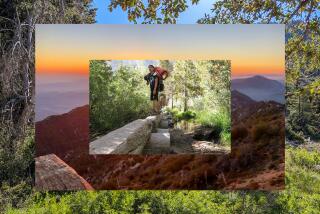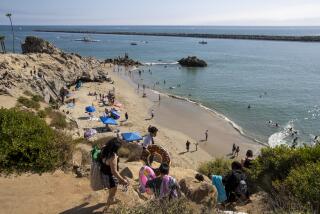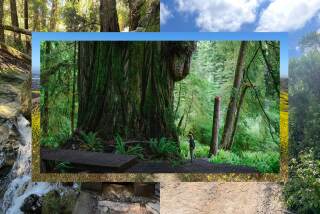State Workers’ Low Rents Not So Cozy for Taxpayers
On a postcard-perfect bluff overlooking the Pacific Ocean, a state park ranger lives in a state-owned cottage overlooking Orange County’s Crystal Cove State Park, a 3.5-mile stretch of coastal parkland between Corona del Mar and Laguna Beach.
His rent: $148 a month.
The cottage is one of 1,181 houses, cabins and dorms across the state provided to employees at 13 state agencies in 2003, at an estimated cost to taxpayers of $8.3 million, according to a report from state Auditor Elaine M. Howle.
State officials have long seen this as a cheap way to provide security at parks and other facilities and also offer housing to workers where there are few affordable units nearby. But some legislators are fuming.
Assemblyman Chuck DeVore (R-Irvine) has been complaining about the Crystal Cove arrangement for months. The park superintendent and three other employees were paying “one-fifteenth the market rate,” he said.
“I was shocked that the levels of rent were so low,” he said. “This buys our state employees panoramic views of the Pacific worth up to $4,000 per month for folks like the rest of us.”
DeVore has sponsored legislation (AB 1708) with Assemblyman Alberto Torrico (D-Newark) that toughens the rules on calculating fair market value for state-owned property. It has passed the Assembly and is waiting to be heard in the Senate.
Of the state agencies reviewed, the Department of Parks and Recreation provided the most housing with 487 units, according to the audit. It said the state could have drawn $4.7 million if the units had been rented at fair market value, compared with about $763,000 it charged its workers.
Among parks in Southern California, Orange County’s San Clemente State Park leads the list with 11 units for workers, followed by Ventura County’s Leo Carrillo State Park with 10.
A parks department spokesman defended the practice, saying rangers and other employees don’t earn much and provide park security “24-7.”
“If you’ve ever been camping, these are the people you wake up at 2, 3 in the morning when your child is lost or there’s a boom box blaring or you’re worried about the people camping next to you,” said Roy Stearns.
He noted that park employees probably couldn’t find affordable rentals near a place such as Crystal Cove, and that many need to live in isolated sites to protect state property.
The audit also faulted the parks department for not conducting appraisals of its properties. But the department doesn’t have appraisers, Stearns said, and its request to hire them was denied.
The audit said the state agencies failed to report $7.7 million in taxable housing benefits to the state and IRS. The perk is the difference between the rent and fair market value.
The auditor’s probe stemmed from a whistle-blower’s tip that some state employees and volunteers had lived rent-free in housing provided by the state Department of Fish and Game in the North Coast region. One employee paid no rent for 21 years.
In all, seven volunteers and six employees had lived rent-free for a total of 718 months from January 1984 to December 2005, at a loss of more than $87,000.
While some Fish and Game employees lived in cabins and dormitories to provide security against theft and vandalism, the audit said: “It appears that most of Fish and Game’s properties may not meet the condition-of-employment test and fringe benefits should have been reported.”
The Fish and Game employee who paid no rent for 21 years was not identified. He lived in a dormitory where the loss to the state was calculated at $8,636, the audit said.
Only two employees remain at Crystal Cove, Stearns said, arguing their presence is required to provide security and assist visitors. The two are the superintendent and another employee, who parks a mobile home there for $18 a month.
Assemblyman DeVore said the superintendent and other rangers lived in cottages in a section of the park with limited public access and no camping. Yet, the superintendent and his family enjoy “a gorgeous ocean view,” and “there’s no way a superintendent is being forced to live there.”
*
(BEGIN TEXT OF INFOBOX)
State park housing perks
*
San Clemente State Beach has the most state-funded, low-cost rental units for park employees in Southern California, followed by Leo Carillo State Park. Eighteen state parks have a total of 75 housing units available to park rangers and maintenance staff.
*
*--* Housing So. Calif. state parks w/units County Acres units* San Clemente State Beach Orange 20 11 Leo Carrillo State Park Ventura 2,500 10 Hungry Valley SVRA Los Angeles 19,000 6 Lake Perris SRA San Bernardino 8,000** 6 Topanga State Park Los Angeles 10,840 6 California Citrus SHP Riverside 380 5 Will Rogers SHP Los Angeles 190 5 Malibu Lagoon State Beach Los Angeles 160 5 Salton Sea SRA Riverside 230,400** 4 Crystal Cove State Park Orange 2,800 3 McGrath State Beach Ventura 320 3 Providence Mountains SRA San Bernardino 5,900 3 Mount San Jacinto State Park Riverside 14,000 2 Antelope Valley Indian Museum Los Angeles 160 2 Chino Hills State Park San Bernardino 12,450 1 Point Mugu State Park Ventura 15,000 1 Silverwood Lake SRA San Bernardino 2,400** 1 Wildwood Canyon San Bernardino 850 1
*--*
* Includes apartments, dorms, houses, mobile homes, trailer pads, cabins and triplexes
** Includes lake acreage
SHP = state historic park; SVRA = state vehicular recreation area; SRA=state recreation area
*
Sources: California Department of Parks and Recreation, Times research.
More to Read
Sign up for Essential California
The most important California stories and recommendations in your inbox every morning.
You may occasionally receive promotional content from the Los Angeles Times.










